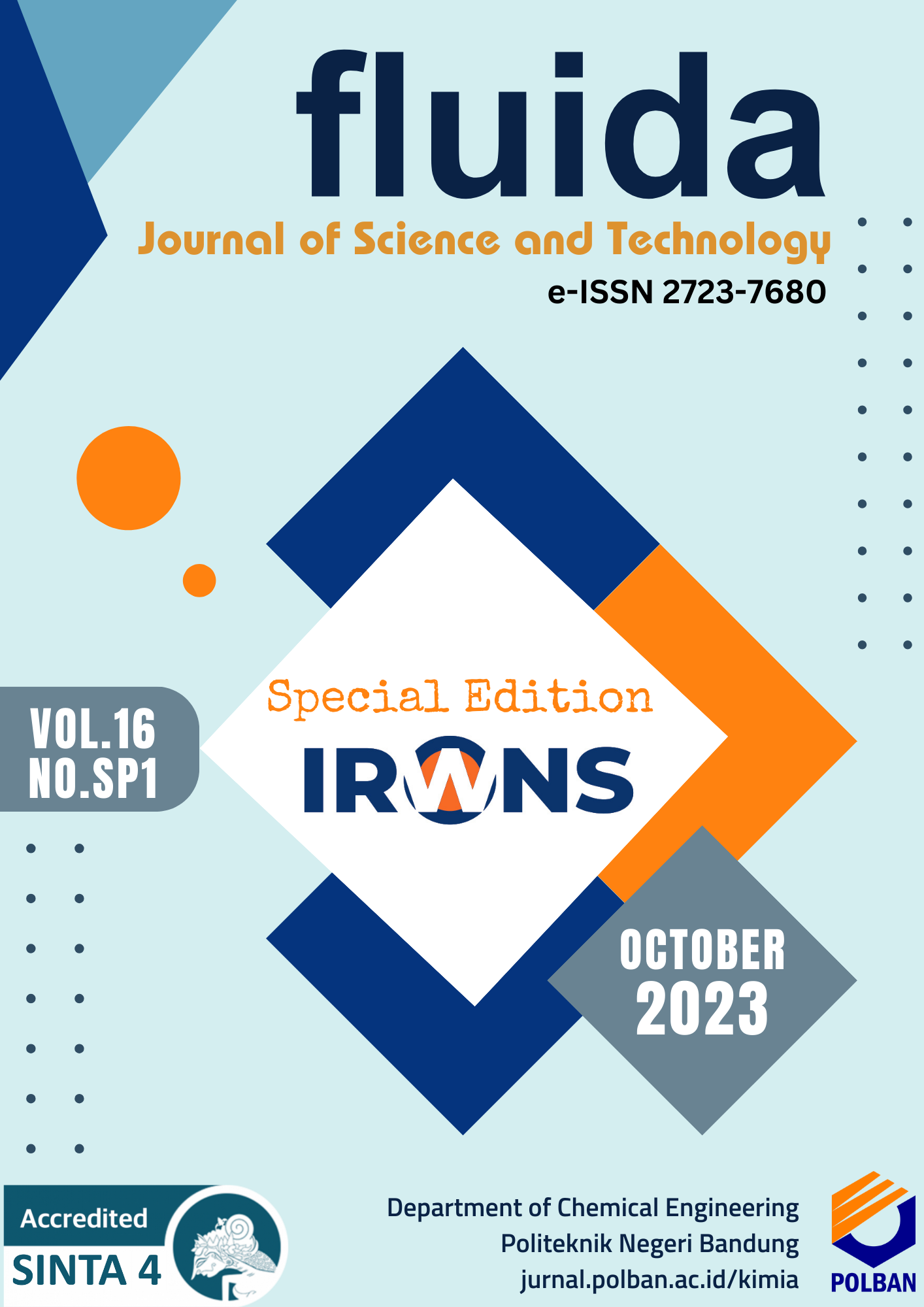Correlation of Steam Velocity and Pipe Diameter with Heat Transfer Performance on 120° Half-Pipe Jacket
Main Article Content
Abstract
Double jacket mixing tanks offer temperature control and versatility for industrial processes where temperature-sensitive materials need to be mixed, stored, or processed. The selection of the appropriate jacket type in a double-jacket mixing tank is based on the structural strength and the optimal heat transfer performance. The type of jackets can be conventional, dimple, and half-pipe. The conventional jacket is easier to manufacture, but it is not resistant to high temperature and pressure. The dimple jacket has good heat transfer, but it is susceptible to damage. The half-pipe jacket has good structural strength, but its heat transfer is affected by the central angle and pipe diameter. 120° central angle has greater heat transfer and pressure drop than 180° central angle. In order to determine the effects of steam velocity on heat transfer performance, heating time, and pressure drop of the 120° half-pipe jacket, research occurred on pipes with 2, 2.5, and 3 inches of diameter. The calculating method of heat transfer in agitated jacketed vessels is applied to visualize the relationships. The effects of steam velocity on heat transfer, heating duration, and pressure drop respectively are polynomials of order 2, power, and polynomials of order 2 with an average R2 close to 1. The greater R2, the better the relationship between two variables, according to the equation. The 120° half-pipe jacket performance will be highly effective, with 1774 W, 2.1 minutes heating duration, 8.94 kPa pressure drop if the steam velocity is 10.50 m/s with 2.5 inches pipe diameter.
Downloads
Article Details

This work is licensed under a Creative Commons Attribution-ShareAlike 4.0 International License.
An author who publishes in the FLUIDA journal agrees to the following terms:
- Author retains the copyright and grants the journal the right of first publication of the work simultaneously licensed under the Creative Commons Attribution-ShareAlike 4.0 License that allows others to share the work with an acknowledgement of the work's authorship and initial publication in this journal
- Author is able to enter into separate, additional contractual arrangements for the non-exclusive distribution of the journal's published version of the work (e.g., post it to an institutional repository or publish it in a book) with the acknowledgement of its initial publication in this journal.
- Author is permitted and encouraged to post his/her work online (e.g., in institutional repositories or on their website) prior to and during the submission process, as it can lead to productive exchanges, as well as earlier and greater citation of the published work (See The Effect of Open Access).
Read more about the Creative Commons Attribution-ShareAlike 4.0 Licence here: https://creativecommons.org/licenses/by-sa/4.0/.
References
J. Zhang, Y. Zhang and J. Wu, "Effect of Varying Pitch and Overlap Scale on Enhanced Heat Transfer of Half-coil Jackets," The Chinese Journal of Process Engineering, vol. XVII, no. 4, pp. 697-703, 2017.
J. E. Frantsen, T. Mathiesen, K. U. Hattesen, P. Cheepsujjayan, B. Bertelsen and H. C. Aller, "Common Corrosion Problems in The Brewery Sector," Force Technology, 2008.
R.-V. Industries, "Pressure Vessels Jacket Selection and Surface Enhancement," 2018.
N. S, "Types of External Jacketed Heat Transfer Surfaces," CMPI Custom Manufacturing & Polishing Inc, 2021.
M. El-Helw, "A Simulation Study of Heat Transfer in Polymerization Reactors," Thermal Science, vol. XXIII, no. 2B, pp. 1127-1138, 2019.
W. Li, "Optimal Design of Fluid Flow and Heat Transfer in Pipe Jackets," Applied Science, vol. XII, no. 7179, 2022.
Z. Wu and C. Qian, "Numerical Investigation of Fluid Flow and Heat Transfer Characteristics," Journal of Physics: Conference Series, vol. MDXLIX, no. 4, 2020.
M. Yang, G. Li, F. Liao, J. Li and X. Zhou, "Numerical study of characteristic influence on heat transfer of supercritical CO2 in helically coiled tube with non-circular cross section," International Journal of Heat and Mass Transfer, vol. CLXXVI, no. 121511, 2021.
Y. A. Cengel, Heat and Mass Transfer: Fundamentals and Applications (5th Edition), New York: McGraw Hill, 2015.
J. Couper, Chemical Process Equipment: Selection and Design (3rd Edition), United Kindom: Elsevier Inc, 2012.
D. Pratama, K. Hadiningrum and R. F. Muldiani, "Studi Awal Pengaruh Temperatur terhadap Karakteristik Aliran Fluida Pada Belokan Pipa 90° melalui Simulasi," JURNAL MIPA, vol. XI, no. 2, pp. 68-71, 2022.
P. Sampelawang, "Karakteristik Perpindahan Panas Heat Exchanger Dalam Enclosure Pada Posisi Simetris Dengan Perubahan Beban Panas," Mechanical Engineering Science (MES), vol. I, no. 2, 2019.
A. Lutfiansyah and A. F. Sudarma, "Analisis Perpindahan Panas Alat Penukar Kalor Shell dan Tube dengan Fluida Kerja Air dan Hidrokarbon Menggunakan Metode Efektivitas-NTU," Jurnal Teknik Mesin, vol. II, no. 3, 2022.
A. Husen, T. M. I. Akbar and N. Cholis, "Analisis Pengaruh Kecepatan Aliran Fluida Dingin Terhadap Efektivitas Shell and Tube Heat Exchanger," BINA TEKNIKA, vol. XVI, no. 1, pp. 1-10, 2020.
E. A. Handoyo, "Pengaruh Kecepatan Aliran Terhadap Efektivitas Shell-and-Tube Heat," Jurnal Teknik Mesin, vol. II, no. 2, pp. 86-90, 2010.
M. R. Salem, K. M. Elshazly, R. Y. Sakr and R. K. Ali, "Effect of Coil Torsion on Heat Transfer and Pressure Drop Characteristics of Shell and Coil Heat Exchanger," Journal of Thermal Science and Engineering Applications, vol. VIII, 2016.
M. T. A. A. Lumintar, F. Jayadi and G. Marausna, "Studi Eksperimental Heat Transfer pada Heat Exchanger dengan Tipe Helical Coil Tube Guna Menurunkan Temperatur Oli Hidrolik," Jurnal Teknik, Elektronik, Engine, vol. VII, no. 1, pp. 79-90, 2021.
R. F. Dream, Heat Transfer in Agitated Jacketed Vessels, Chemical Engineering, Amerika Serikat: Lockwood Greene Engineers Inc, 1999.
M. Sheikholeslami, Application of Control Volume based Finite Element Method (CVFEM) for Nanofluid Flow and Heat Transfer, Amsterdam: Elsevier Inc, 2019.
ASME, Boiler and Pressure Vessel Code. Section VIII Rules for Construction of Pressure Vessels. Division 2 Alternative Rules., New York, 2021.

